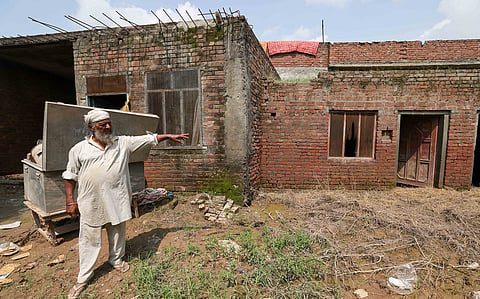

This is the third of a 7-part series. Read the first, second, fourth, fifth, sixth and seventh parts
The floods of 2025 have set the farming community in Punjab, India’s breadbasket, by a decade, farmers have told Down To Earth (DTE).
DTE headed north from Amritsar toward the banks of the Ravi to get an idea of the devastation caused by the floods. After covering roughly 20 kilometres, entire fields were seen submerged in water. The scars of the tragedy were visible, across several villages. A breach in the Dhussi bunds (embankments) caused floodwaters to spread 10 to 12 kilometres. Machhiwal and Ghonewala villages, just about four kilometers from the Ravi’s banks, were the worst affected. Paddy and sugarcane crops here were completely destroyed.
In Ghonewala village, farmer Attar Singh’s house is filled with two feet of silt. The structure is no longer habitable. Singh had planted two acres of paddy and eight acres of sugarcane across his 10 acres this season. Currently, his fields are still submerged, and the crops have rotted.
Singh said his crops faced similar destruction in 2023 as well. Though compensation was promised then, none was received. He doubted as to whether he would get any compensation this time as well. During official crop assessments, the losses of small farmers are often ignored. Due to corruption, farmers are forced to pay bribes, leaving the genuinely affected unassisted.
Another farmer from Ghonewala, Joban Singh, made a striking statement: “We farmers have gone back 10 years.”
“I own four acres. The first flood hit in 2019, and then in 2023. Both times, my crops were destroyed. For the 2023 flood, I received just Rs 1,500 in compensation.” Joban added that it will take nearly two years before his fields can yield crops again.
Farmers who cultivate on leased land face even greater hardships, as their debts are higher. Joban himself had taken a loan of Rs 300,000 to build a house and another Rs 200,000 from a moneylender at 24 per cent annual interest to repair his fields and plant this season’s crops.
With great effort, he managed to lease an additional four acres besides his own four-acre farm this season. On these, he planted PR 127 on four acres, Pusa 1692 on two acres, and sugarcane on 2.5 acres. All of these crops have now been destroyed.
Moreover, in a sharing arrangement, he had planted around 400 poplar trees on two acres, which were either swept away by the floodwaters or are now rotting. “Our future looks completely dark. When a farmer has animals at home but no milk comes from them, you can imagine the hardships we face,” Joban said.
He appealed to the government to genuinely help farmers like him by conducting corruption-free surveys of their fields through patwaris (revenue officials) and providing assistance in fertilisers, seeds, urea, and field restoration.
In the future, water released into the Ravi should not exceed its capacity, said Joban. He alleged that instead of 300,000 cusecs, three to four times that amount was released this time, and asked: why?
In Ghonewala, another farmer, Sukhmanpreet, said his 1.5-acre sugarcane field is now buried under three feet of sand. He asked, “How will we remove this sand without help?”
These questions reflect the struggle of every small and medium farmer along the banks of the Ravi, Beas, and Sutlej in Punjab, who are continuously battling the devastating impact of floods.